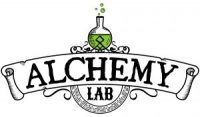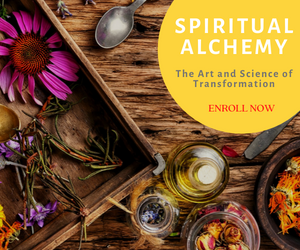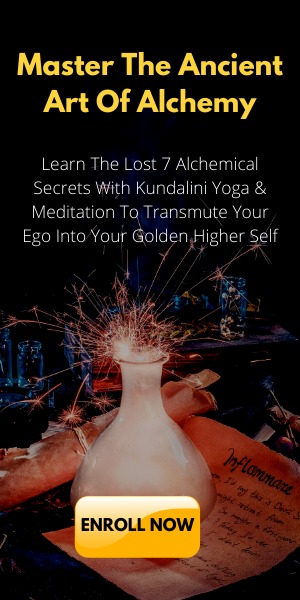History of Alchemy from Ancient Egypt to Modern Times
History of Alchemy
The Alchemists
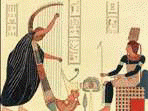
The roots of alchemy date back to ancient Egypt and a mysterious document called the Emerald Tablet.
To most of us, the word “alchemy” calls up the picture of a medieval and slightly sinister laboratory in which an aged, black-robed wizard broods over the crucibles and alembics that are to bring within his reach the Philosopher’s Stone, and with that discovery, the formula for the Elixir of life and the transmutation of metals. But one can scarcely dismiss so lightly the science — or art, if you will –that won to its service the lifelong devotion of men of culture and attainment from every race and clime over a period of thousands of years, for the beginnings of alchemy are hidden in the mists of time. Such a science is something far more than an outlet for a few eccentric old men in their dotage.
What was the motive behind their constant strivings, their never-failing patience in the unravelling of the mysteries, the tenacity of purpose in the face of persecution and ridicule through the countless ages that led the alchemists to pursue undaunted their appointed way? Something far greater, surely, than a mere vainglorious desire to transmute the base metals into gold, or to brew a potion to prolong a little longer this earthly span, for the devotees of alchemy in the main cared little for such things.
The accounts of their lives almost without exception lead us to believe that they were concerned with things spiritual rather than with things temporal. They were men inspired by a vision, a vision of man made perfect, of man freed from disease and the limitations of warring faculties both mental and physical, standing godlike in the realization of a power that even at this very moment of time lies hidden in the deeper strata of consciousness, a vision of man made truly in the image and likeness of the One Divine Mind in its Perfection, Beauty, and Harmony.
To appreciate and understand the adepts’ visions, it is necessary to trace the history of their philosophy. So let us for step back into the past to catch a glimpse of these men, of their work and ideals, and more important still, of the possibilities that their life-work might bring to those who today are seeking for fuller knowledge and wider horizons.
Chinese Alchemy
References about alchemy are to be found in the myths and legends of ancient China. From a book written by Edward Chalmers Werner, a late member of the Chinese Government’s Historiological Bureau in Peking comes this quotation from old Chinese records: “Chang Tao-Ling, the first Taoist pope, was born in A.D. 35 in the reign of the Emperor Kuang Wu Ti of the Hari dynasty. His birthplace is variously given as T’ien-mu Shan, Lin-an-Hsien in Chekiang, Feng-yang Fu in Anhui, and even in the “Eye of Heaven Mountain.” He devoted himself wholly to study and meditation, declining all offers to enter the service of the state. He preferred to take up his abode in the mountains of Western China where he persevered in the study of alchemy and in cultivating the virtues of purity and mental abstraction. From the hands of the alchemist Lao Tzu, he received supernaturally a mystical treatise, by following the instructions in which he was successful in his match for the Elixir of Life.” This reference demonstrates that alchemy was studied in China before the commencement of the Christian era and its origin must lie even further back in Chinese history.
Egyptian Alchemy
From China we now travel to Egypt, from where alchemy as it is known in the West seems to have sprung. The great Egyptian adept king, named by the Greeks “Hermes Trismegistus” is thought to have been the founder of the art. Reputed to have lived about 1900 B.C., he was highly celebrated for his wisdom and skill in the operation of nature, but of the works attributed to him only a few fragments escaped the destroying hand of the Emperor Diocletian in the third century A.D. The main surviving documents attributed to him are the Emerald Tablet, the Asclepian Dialogues, and the Divine Pymander. If we may judge from these fragments (both preserved in the Latin by Fianus and translated into other languages in the sixteenth century), it would seem to be of inestimable loss to the world that none of these works have survived in their entirety.
The famous Emerald Tablet (Tabula Smaragdina) of Hermes is the primary document of alchemy. There have been various stories of the origin of the tract, one being that the original emerald slab upon which the precepts were said to be inscribed in Phoenician characters was discovered in the tomb of Hermes by Alexander the Great. In the Berne edition (1545) of the Summa Perfectionis, the Latin version is printed under the heading: “The Emerald Tables of Hermes the Thrice Great Concerning Chymistry, Translator unknown. The words of the secrets of Hermes, which were written on the Tablet of Emerald found between his hands in a dark cave wherein his body was discovered buried.”
Arabian Alchemy
An Arabic version of the text was discovered in a work ascribed to Jabir (Geber), which was probably made about the ninth century. In any case, it must be one of the oldest alchemical fragments known, and that it is a piece of Hermetic teaching I have no doubt, as it corresponds to teachings of the Thrice-Greatest Hermes as they have been passed down to us in esoteric circles. The tablet teaches the unity of matter and the basic truth that all form is a manifestation from one root, the One Thing or Ether. This tablet, in conjunction with the works of the Corpus Hermeticum are well worth reading, particularly in the light of the general alchemical symbolism. Unhappily, the Emerald Tablet is all that remains to us of the genuine Egyptian sacred art of alchemy.
The third century A.D. seems to have been a period when alchemy was widely practiced, but it was also during this century, in the year 296, that Diocletian sought out and burnt all the Egyptian books on alchemy and the other Hermetic sciences, and in so doing destroyed all evidence of any progress made up to that date. In the fourth century, Zosimus the Panopolite wrote his treatise on The Divine Art of Making Gold and Silver, and in the fifth Morienus, a hermit of Rome, left his native city and set out to seek the sage Adfar, a solitary adept whose fame had reached him from Alexandria. Morienus found him, and after gaining his confidence became his disciple. After the death of his patron, Morienus came into touch with King Calid, and a very attractive work purporting to be a dialogue between himself and the king is still extant under the name of Morienus. In this century, Cedrennus also appeared, a magician who professed alchemy.
The next name of note, that of Geber, occurs in or about 750 A.D. Geber’s real name was Abou Moussah Djfar-Al Sell, or simply “The Wise One.” Born at Houran in Mesopotamia, he is generally esteemed by adepts as the greatest of them all after Hermes. Of the five hundred treatises said to have been composed by him, only three remain to posterity: The Sum of the Perfect Magistery, The Investigation of Perfection, and his Testament. It is to him, too, that we are indebted for the first mention of such important compounds as corrosive sublimate, red oxide of mercury, and nitrate of silver. Skillfully indeed did Geber veil his discoveries, for from his mysterious style of writing we derive the word “gibberish,” but those who have really understood Geber, his adept peers, declare with one accord that he has declared the truth, albeit disguised, with great acuteness and precision.
About the same time, Rhasis, another Arabian alchemist, became famous for his practical displays in the art of transmutation of base metals into gold. In the tenth century, Alfarabi enjoyed the reputation ofbeing the most learned man of his age, and still another great alchemist of that century was Avicenna, whose real name was Ebu Cinna. Born at Bokara in 980 A.D., he was the last of the Egyptian alchemical philosophers of note.
European Alchemy
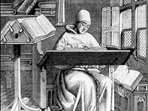
Alchemy arrived in Spain during the Arabian occupation by the Moors and then spread into the rest of Europe.
About the period of the first Crusades, alchemy shifted its center to Spain, where it had been introduced by the Arabian Moors. In the twelfth Century Artephius wrote The Art of Prolonging Human Life and is reported to have lived throughout a period of one thousand years. He himself affirmed this:
“I, Artephius, having learnt all the art in the book of Hermes, was once as others, envious, but having now lived one thousand years or thereabouts (which thousand years have already passed over me since my nativity, by the grace of God alone and the use of this admirable Quintessence), as I have seen, through this long space of time, that men have been unable to perfect the same magistry on account of the obscurity of the words of the philosophers, moved by pity and good conscience, I have resolved, in these my last days, to publish in all sincerity and truly, so that men may have nothing more to desire concerning this work. I except one thing only, which is not lawful that I should write, because it can be revealed truly only by God or by a master. Nevertheless, this likewise may be learned from this book, provided one be not stiff-necked and have a little experience.”
Of the thirteenth-century literature, a work called Tesero was attributed to Alphonso, the King of Castile, in 1272. William de Loris wrote Le Roman de Rose in 1282, assisted by Jean de Meung, who also wrote The Remonstrance of Nature to the Wandering Alchemist and The Reply of the Alchemist to Nature. Peter d’Apona, born near Padua in 1250, wrote several books on Hermetic sciences and was accused by the Inquisition of possessing seven spirits (each enclosed in a crystal vessel) who taught him the seven liberal arts and sciences. He died upon the rack.
Among other famous names appearing about this period is that of Arnold de Villeneuve or Villanova, whose most famous work is found in the Theatrum Chemicum. He studied medicine in Paris but was also a theologian and an alchemist. Like his friend, Peter d’Apona, he was accused of obtaining his knowledge from the devil and was charged by many different people with magical practices. Although he did not himself fall into the hands of the Inquisition, his books were condemned to be burnt in Tarragona by that body on account of their heretical content. Villanova’s crime was that he maintained that works of faith and charity are more acceptable in the eyes of God than the Sacrificial Mass of the Church!
The authority of Albertus Magnus (1234-1314) is undoubtedly to be respected, since he renounced all material advantages to devote the greater part of a long life to the study of alchemical philosophy in the seclusion of a cloister. When Albertus died, his fame descended to his “sainted pupil” Aquinas, who in his Thesaurus Alchimae, speaks openly of the successes of Albertus and himself in the art of transmutation.
Raymond Lully is one of the medieval alchemists about whose life there is so much conflicting evidence that it is practically certain that his name was used as a cover by at least one other adept either at the same or a later period. The enormous output of writings attributed to Lully (they total about 486 treatises on a variety of subjects ranging from grammar and rhetoric to medicine and theology) also seems to suggest that his name became a popular pseudonym. Lully was born in Majorca about the year 1235, and after a somewhat dissolute youth, he was induced, apparently by the tragic termination of an unsuccessful love affair, to turn his thoughts to religion. He became imbued with a burning desire to spread the Hermetic teachings among the followers of Mohammed, and to this end devoted years to the study of Mohammedan writings, the better to refute the Moslem teachings. He traveled widely, not only in Europe, but in Asia and Africa, where his religious zeal nearly cost him his life on more than one occasion. Lully is said to have become acquainted with Arnold de Villanova and the Universal Science somewhat late in life, when his study of alchemy and the discovery of the Philosophers’ Stone increased his former fame as a zealous Christian.
According to one story, his reputation eventually reached John Cremer, Abbot of Westminster at the time. After working at alchemy for thirty years, Cremer had still failed to achieve his aim, the Philosopher’s Stone. Cremer therefore sought out Lully in Italy, and having gained his confidence, persuaded him to come to England, where he introduced him to King Edward II. Lully, being a great champion of Christendom, agreed to transmute base metals into gold on the condition that Edward carry on the Crusades with the money. He was given a room in the Tower of London for his work, and it is estimated that he transmuted 50,000 pounds worth of gold. After a time, however, Edward became avaricious, and to compel Lully to carry on the work of transmutation, made him prisoner. However, with Cremer’s aid, Lully was able to escape from the Tower and return to the Continent. Records state that he lived to be one hundred and fifty years of age and was eventually killed by the Saracens in Asia. At that age he is reputed to have been able to run and jump like a young man.
During the fourteenth century, the science of alchemy fell into grave disrepute, for the alchemists claim to transmute metals offered great possibilities to any rogue with sufficient plausibility and lack of scruple to exploit the credulity or greed of his fellowmen. In fact, there proved to be no lack either of charlatans or victims. Rich merchants and others greedy for gain were induced to entrust to the alleged alchemists gold, silver, and precious stones in the hope of getting them multiplied, and Acts of Parliament were passed in England and Pope’s Bulls issued over Christendom to forbid the practice of alchemy on pain of death. (Although Pope John XXII is said to have practiced the art himself and to have enriched the Vatican treasury by this means.) Before long, even the most earnest alchemists were disbelieved. For example, there lived about this time the two Isaacs Hollandus (a father and son), who were Dutch adepts and wrote De Triplici Ordinari Exiliris et Lapidis Theoria andMineralia Opera Sue de Lapide Philosophico. The details of their operations on metals are the most explicit that had ever been given, yet because of their very lucidity, their work was widely discounted.
The English Alchemists
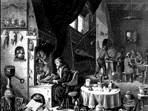
Alchemy reigned as the supreme science in Europe for 1,700 years.
In England, the first known alchemist was Roger Bacon, who was a scholar of outstanding attainment. Born in Somersetshire in 1214, he made extraordinary progress even in his boyhood studies, and on reaching the required age joined the Franciscan Order. After graduating Oxford, he moved to Paris where he studied medicine and mathematics. On his return to England, he applied himself to the study of philosophy and languages with such success that he wrote grammars of the Latin, Greek, and Hebrew tongues.
Although Bacon has been described as a physician rather than an alchemist, we are indebted to him for many scientific discoveries. He was almost the only astronomer of his time, and in this capacity rectified the Julian calendar which, although submitted to Pope Clement IV in 1267, was not put into practice until a later papacy. He was responsible also for the physical analysis of convex glasses and lenses, the invention of spectacles and achromatic lenses, and for the theory of the telescope. As a student of chemistry, he called attention to the chemical role played by air in combustion, and having carefully studied the properties of saltpeter, taught its purification by dissolution in water and by crystallization.
Indeed, from his letters we learn that Bacon anticipated most of the achievements of modern science. He maintained that vessels might be constructed that would be capable of navigation without manual rowers, and which under the direction of a single man, could travel through the water at a speed hitherto undreamed of. He also predicted that it would be possible to construct cars that could be set in motion with amazing speeds (“independently of horses and other animals”) and also flying machines that would beat the air with artificial wings.
It is scarcely surprising that in the atmosphere of superstition and ignorance that reigned in Europe during the Middle Ages, Bacon’s achievements were attributed to his communication with devils. His fame spread through western Europe not as a savant but as a great magician. His great services to humanity were met with censure, not gratitude, and to the Church his teachings seemed particularlypernicious. The Church took her place as one of his foremost adversaries, and even the friars of his own order refused his writings a place in their library. His persecutions culminated in 1279 in imprisonment and a forced repentance of his labors in the cause of art and science.
Among his many writings, there are two or three works on alchemy, from which it is quite evident that not only did he study and practice the science but that he obtained his final objective, the Philosopher’s Stone. Doubtless during his lifetime, his persecutions led him to conceal carefully his practice of the Hermetic art and to consider the revelation of such matters unfit for the uninitiated. “Truth,” he wrote, “ought not to be shown to every ribald person, for then it would become most vile that which, in the hand of a philosopher, is the most precious of all things.”
Sir George Ripley, Canon of Bridlington Cathedral in Yorkshire, placed alchemy on a higher level than many of his contemporaries by dealing with it as a spiritual and not merely a physical manifestation. He maintained that alchemy is concerned with the mode of our spirit’s return to the God who gave it to us. He wrote in 1471 his Compound of Alchemy with its dedicatory epistle to King Edward IV. It is also reported in the Canon of Bridlington that he provided funds for the Knights of St. John by means of the Philosopher’s Stone he concocted.
In the sixteenth century, Pierce the Black Monk, wrote the following about the Elixir: “Take earth of Earth, Earth’s Mother (Water of Earth), Fire of Earth, and Water of the Wood. These are to lie together and then be parted. Alchemical gold is made of three pure soul, as purged as crystal. Body, seat, and spirit grow into a Stone, wherein there is no corruption. This is to be cast on Mercury and it shall become most worthy gold.” Other works of the sixteenth century include Thomas Charnock’s Breviary of Philosophy and Enigma published in 1572. He also wrote a memorandum in which he states that he attained the transmuting powder when his hairs were white with age.
Also in the sixteenth century lived Edward Kelly, born in 1555. He seems to have been an adventurer of sorts and lost his ears at Lancaster on an accusation of producing forged title deeds. Dr. John Dee, a widely respected and learned man of the Elizabethan era, was very interested in Kelly’s clairvoyant visions, although it is difficult to determine whether Kelly really was a genuine seer since his life was such an extraordinary mixture of good and bad character. In some way or other, Kelly does appear to have come into possession of the Red and White Tinctures. Elias Ashmole printed at the end of Theatrum Chemicum Britannicum a tract entitled Sir Edward Kelly’s Work that says: “It is generally reported that Doctor Dee and Sir Edward Kelly were so strangely fortunate as to find a very Iarge quantity of the Elixir in some part of the ruins of Glastonbury Abbey, which was so incredibly rich in virtue (being one in 272,330), that they lost much in making projection by way of trial before they finally found out the true height of the medicine.”
In March 1583, a prince of Poland, the Count Palatine of Siradia, Adalbert Alask, while visiting the Court of Queen Elizabeth, sought to meet with Dr. Dee to discuss his experiments, of which he became so convinced that he asked Dee and Kelly and their families to accompany him on his return to Cracow. The prince took them from Cracow to Prague in anticipation of favors at the hand of Emperor Rudolph II, but their attempt to get into touch with Rudolph was unsuccessful. In Prague at that time there was a great interest in alchemy, but in 1586, by reason of an edict of Pope Sixtus V, Dee and Kelly were forced to flee the city. They finally found peace and plenty at the Castle of Trebona in Bohemia as guests of Count Rosenberg, the Emperor’s Viceroy in that country. During that time Kelly made projection of one minim on an ounce and a quarter of mercury and produced nearly an ounce of the best gold.
In February 1588, the two men parted ways, Dee making for England and Kelly for Prague, where Rosenberg had persuaded the Emperor to quash the Papal decree. Through the introduction of Rosenberg, Kelly was received and honored by Rudolph as one in possession of the Great Secret of Alchemy. From him he received besides a grant of land and the freedom of the city, a position of state and apparently a title, since he was known from that time forward as Sir Edward Kelly. These honors are evidence that Kelly had undoubtedly demonstrated to the Emperor his knowledge of transmutation, but the powder of projection had now diminished, and to the Emperor’s command to produce it in ample quantities, he failed to accede, being either unable or unwilling to do so. As a result, Kelly was cast into prison at the Castle of Purglitz near Prague where he remained until 1591 when he was restored to favor. He was interned a second time, however, and in 1595, according to chronicles, and while attempting to escape from his prison, fell from a considerable height and was killed at the age of forty.
In the seventeenth century lived Thomas Vaughan, who used the pseudonym “Eugenius Philasthes” (and possibly “Eireneus Philalethes” as well) and wrote dozens of influential treatises on alchemy. Among Vaughan’s most noteworthy books are An Open Entrance to the Shut Palace of the King, Ripley Revived, The Marrow of Alchemy, Metallorum Metamorphosis, Brevis Manuductio ad Rubinem Coelestum, Fone Chemicae Veritatis, and others to be found in the Musaeum Hermiticum. Vaughan came from Wales and his writings were regarded as an illustration of the spiritual approach to alchemy. Yet whatever the various interpretations put upon his work, Vaughan was undoubtedly endeavoring to show that alchemy was demonstrable, in every phase of physical, mental, and spiritual reality. His work Lumen de Lumine is an alchemical discourse that deals with those three aspects. His medicine is a spiritual substance inasmuch as it is the Quintessence or the Divine Life manifesting through all form, both physical and spiritual. His gold is the gold of the physical world as well as the wisdom of the spiritual world. His Stone is the touchstone that transmutes everything and is again both spiritual and physical. For instance, his statement “the Medicine can only be contained in a glass vessel” signifies a tangible glass container as well the purified body of the adept.
Thomas Vaughan was a Magus of the Rosicrucian Order, and he knew and understood that the science of alchemy must manifest throughout all planes of consciousness. Writing as Eireneus Philalethes in the preface to the An Open Entrance from the Collectanea Chymica (published by William Cooper in 1684), Vaughan says: “I being an adept anonymous, a lover of learning, and philosopher, decreed to write this little treatise of medicinal, chemical, and physical secrets in the year of he world’s redemption 1645, in the three and twentieth year of my life, that I may pay my duty to the Sons of the Art, that I might appear to other adepts as their brother and equal. Therefore I presage that not a few will be enlightened by these my labors. These are no fables, but real experiments that I have made and know, as every other adept will conclude by these lines. In truth, many times I laid aside my pen, deciding to forbear from writing, being rather willing to have concealed the truth under a mask of envy. But God compelled me to write, and Him I could in no wise resist who alone knows the heart and unto whom be glory forever. I believe that many in this last age of the world will be rejoiced with the Great Secret, because I have written so faithfully, leaving of my own will nothing in doubt for a young beginner. I known many already who possess it in common with myself and are persuaded that I shall yet be acquainted in the immediate time to come. May God’s most holy will be done therein. I acknowledge myself totally unworthy of bringing those things about, but in such matters I submit in adoration to Him, to whom all creation is subject, who created All to this end, and having created, preserves them.”
He then goes on to give an account of the transmutation of base metals into silver and gold, and he gives examples of how the Medicine, administered to some at the point of death, affected their miraculous recovery. Of another occasion he writes: “On a time in a foreign country, I could have sold much pure alchemical silver (worth 600 pounds), but the buyers said unto me presently that they could see the metal was made by Art. When I asked their reasons, they answered: ‘We know the silver that comes from England, Spain, and other places, but this is none of these kinds.’ On hearing this I withdrew suddenly, leaving the silver behind me, along with the money, and never returning.”
Again he remarks: “I have made the Stone. I do not possess it by theft but by the gift of God. I have made it and daily have it in my power, having formed it often with my own hands. I write the things that I know.”
In the last chapter of the Open Entrance is his message to those who have attained the goal. “He who hath once, by the blessing of God, perfectly attained this Art,” says Vaughan, “I know not what in the world he can wish but that he may be free from all the snares of wicked men, so as to serve God without distraction. But it would be a vain thing by outward pomp to seek for vulgar applause. Such trifles are not esteemed by those who truly have this Art — nay, rather they despise them. He therefore whom God has blessed with this talent behaves thus. First, if he should live a thousand years and everyday provide for a thousand men, he could not want, for he may increase his Stone at his pleasure, both in weight and virtue so that if a man would, one man might transmute into perfect gold and silver all the imperfect metals that are in the whole world. Secondly, he may by this Art make precious stones and gems, such as cannot be paralleled in Nature for goodness and greatness. Thirdly and lastly, he has a Medicine Universal, both for prolonging life and curing all diseases, so that one true adept can easily cure all the sick people in the world. I mean his Medicine is sufficient. Now to the King, eternal, immortal and sole mighty, be everlasting praise for these His unspeakable gifts and invaluable treasures. Whosoever enjoys his talent, let him be sure to employ it to the glory of God and the good of his neighbors, lest he be found ungrateful to the Source that has blessed him with so great a talent and be in the last found guilty of disproving it and so condemned.”
From England, there is also the story of a transmutation performed before King Gustavus Adolphus in 1620, the gold of which was coined into medals, bearing the king’s effigy with the reverse Mercury and Venus; and of another at Berlin before the King of Prussia.
In the same century, Alexander Seton, a Scot, suffered indescribable torments for his knowledge of the art of transmutation. After practicing in his own country he went abroad, where he demonstrated his transmutations before men of good repute and integrity in Holland, Hamburg, Italy, Basle, Strasbourg, Cologne, and Munich. He was finally summoned to appear before the young Elector of Saxony, to whose court he went somewhat reluctantly. The Elector, on receiving proof of the authenticity of his projections, treated him with distinction, convinced that Seton held the secret of boundless wealth. But Seton refused to initiate the Elector into his secret and was imprisoned in Dresden. As his imprisonment could not shake his resolve, he was put to torture. He was pierced, racked, beaten, scarred with fire and molten lead, but still he held his peace. At length he was left in solitary confinement, until his escape was finally engineered by the Polish adept Sendivogius. Even to this dear friend, he refused to reveal the secret until shortly before his death. Two years after his escape from prison, he presented Sendivogius with his transmuting powder.
Alchemy in the Seventeenth and Eighteenth Centuries

Many of the cathedrals of the Middle Ages carry alchemical symbols and secret formulae.
The first man to teach the chemistry of the human body and to declare that the true purpose of alchemy was the preparation of medicine for the treatment of disease was one Jean Baptista Van Helmont, a disciple of Paracelsus. Van Helmont has been called the “Descartes of Medicine” for his probing philosophical discourses. But he was also an accomplished alchemist. In his treatise, De Natura Vitae Eternae, he wrote: “I have seen and I have touched the Philosopher’s Stone more than once. The color of it was like saffron in powder but heavy and shining like pounded glass. I had once given me the fourth of a grain, and I made projection with this fourth part of a grain wrapped in paper upon eight ounces of quicksilver heated in a crucible. The result of the projection was eight ounces, lacking just eleven grains, of the most pure gold.”
In his early thirties, Van Helmont retired to an old castle in Belgium near Brussels and remained there, almost unknown to his neighbors until his death in his sixty-seventh year. He never professed to have actually prepared the Philosopher’s Stone, but he say he gained his knowledge from alchemists he contacted during his years of research.
Van Helmont also gives particulars of an Irish gentleman called Butler, a prisoner in the Castle of Vilvord in Flanders, who during his captivity performed strange cures by means of Hermetic medicine. The news of his cure of a Breton monk, a fellow-prisoner suffering from severe erysipelas, by the administration of almond milk in which he had merely dipped the Philosopher’s Stone brought Van Helmont, accompanied by several noblemen, rushing to the castle to investigate. In their presence Butler cured an aged woman of “megrim” by dipping the Stone into olive oil and then anointing her head. There was also an abbess who had suffered for eighteen years with paralyzed fingers and a swollen arm. These disabilities were removed by applying the Stone a few times to her tongue.
In Lives of the Alchemystical Philosophers (published in 1815), it is stated that prior to the events at Vilvord, Butler attracted some attention by his transmutations in London during the reign of King James I. Butler is said to have gained his knowledge in Arabia in a rather roundabout way. When a ship on which he had taken passage was captured by African pirates, he was taken prisoner and sold into slavery in Arabia. His Arab master was an alchemist with knowledge of the correct order of the processes. Butler assisted him in some of his operations, and when he later escaped from captivity, he carried off a large portion of a red powder, which was the alchemical Powder of Projection.
Dennis Zachare in his memoirs gives an interesting account of his pursuit of the Philosopher’s Stone during this period. At the age of twenty, he set out to Bordeaux to undertake a college curriculum, and hence to Toulouse for a-course of law. In this town, he made the acquaintance of some students in possession of a number of alchemical books. It seems that at this time there was a craze for alchemical experiments among the students of Paris and other French towns, and this craze caught Zachare’s imagination. His law studies were forsaken and his experiments in alchemy began. On his parents’ death, having expended all his money on his new love, he returned home and from their estate raised further money to continue his research. For ten years, according to his own statement, after experiments of all sorts and meetings with countless men with various methods to sell, he finally sat down himself to study carefully the writings of the philosophers on the subject. He states that it was Raymond Lully’s Testament, Codicil, and Epistle (addressed to King Robert) that gave him the key to the secret. From the study of this book and The Grand Rosary of Arnold de Villanova, he formulated a plan entirely different from any he had previously followed. After another fifteen months of toil, he says “I beheld with transport the evolution of the three successive colors that testify to the True Work. It came finally at Eastertide. I made a projection of my divine powder on quicksilver, and in less than an hour it was converted into fine gold. God knows how joyful I was, how I thanked Him for this great grace and favor and prayed for His Holy Spirit to pour yet more light upon me that I might use what I had already attained only to His praise and honor.” In his only writing (titled Opusculum Chemicum), Zachare gives his own personal narrative and states that the Great Art is the gift of God alone. The methods and possibilities of the transmutation of metals and the Elixir as a medicine are also considered.
There is also the evidence of John Frederick Helvetius, as he testified in 1666. He made claim to be an adept, but admitted he received the Powder of Transmutation from another alchemist. He wrote: “On December 27th, 1666, in the forenoon, there came a certain man to my house who was unto me a complete stranger, but of an honest, grave and authoritative mien, clothed in a simple garb like that of a Memnonite. He was of middle height, his face was long and slightly pock-marked, his hair was black and straight, his chin close-shaven, his age about forty-three or forty-four, and his native place North Holland, so far as I could make out. After we had exchanged salutations, he inquired whether he might have some conversation with me. It was his idea to speak of the ‘Pyrotechnic Art,’ since he had read one of my tracts, being that directed against the Sympathetic Powder of Sir Kenelm Digby, in which I implied a suspicion whether the Great Arcanum of the Sages was not after all a gigantic hoax. He took therefore this opportunity of asking if indeed I could not believe that such a Grand Mystery might exist in the nature of things, being that by which a physician could restore any patient whose vitals were not irreparably destroyed. My answer allowed that such a Medicine would be a most desirable acquisition for any doctor and that none might tell how many secrets there may be hidden in Nature, but that as for me — though I had read much on the truth of this Art — it had never been my fortune to meet with a master of alchemical science. I inquired further whether he was himself a medical man since he spoke.so learnedly about medicine, but he disclaimed my suggestion modestly, describing himself as a blacksmith, who had always taken great interest in the extraction of medicines from metals by means of fire.
“After some further talk the ‘craftsman Elias’ — for so he called himself — addressed me thus: ‘Seeing that you have read so much in the writings of the alchemists concerning the Stone, its substance, color, and its wonderful effects, may I be allowed to question whether you have yourself prepared it?’
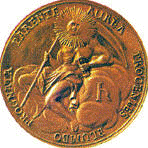
Coin minted from alchemical gold showing the symbol for lead raised to the heavens.
“On my answering him in the negative, he took from his bag an ivory box of cunning workmanship in which there were three large pieces of a substance resembling glass or pale sulfur and informed me that here was enough of his tincture there to produce twenty tons of gold. When I held the treasure in my hands for some fifteen minutes listening to his accounting of its curative properties, I was compelled to return it (not without a certain degree of reluctance). After thanking him for his kindness, I asked why it was that his tincture did not display that ruby color that I had been taught to regard as characteristic of the Philosophers’ Stone. He replied that the color made no difference and that the substance was sufficiently mature for all practical purposes. He brusquely refused my request for a piece of the substance, were it no larger than a coriander seed, adding in a milder tone that he could not do so for all the wealth which I possessed; not indeed on amount of its preciousness but for another reason that it was not lawful to divulge, Indeed, if fire could be destroyed by fire, he would cast it rather into the flames.
“Then, after some consideration, he asked whether I could not show him into a room at the back of the house, where we should be less liable to observation. Having led him into the parlor, he requested me to produce a gold coin, and while I was finding it he took from his breast pocket a green silk handkerchief wrapped about five gold medals, the metal of which was infinitely superior to that of my own money. Being filled with admiration, I asked my visitor how he had attained this most wonderful knowledge in the world, to which he replied that it was a gift bestowed upon him freely by a friend who had stayed a few days at his house, and who had taught him also how to change common flints and crystals into stones more precious than rubies and sapphires. ‘He made known to me further,” said the craftsman, ‘the preparation of crocus of iron, an infallible cure for dysentery and of a metallic liquor, which was an efficacious remedy for dropsy, and of other medicines.’ To this, however, I paid no great heed as I was impatient to hear about the Great Secret. The craftsman said further that his master caused him to bring a glass full of warm water to which he added a little white powder and then an ounce of silver, which melted like ice therein. ‘Of this he emptied one half and gave the rest to me,’ the craftsman related. ‘Its taste resembled that of fresh milk, and the effect was most exhilarating.’
“I asked my visitor whether the potion was a preparation of the Philosophers’ Stone, but he replied that I must not be so curious. He added presently that at the bidding of his master, he took down a piece of lead water-pipe and melted it in a pot. Then the master removed some sulfurous powder on the point of a knife from a little box, cast it into the molten lead, and after exposing the compound for a short time to a fierce fire, he poured forth a great mass of liquid gold upon the brick floor of the kitchen. The master told me to take one-sixteenth of this gold as a keepsake for myself and distribute the rest among the poor (which I did by handing over a large sum in trust for the Church of Sparrendaur). Before bidding me farewell, my friend taught me this Divine Art.’
“When my strange visitor concluded his narrative, I pleaded with him to prove his story by performing a transmutation in my presence. He answered that he could not do so on that occasion but that he would return in three weeks, and, if then at liberty, would do so. He returned punctually on the promised day and invited me to take a walk, in the course of which we spoke profoundly on the secrets of Nature he had found in fire, though I noticed that my companion was exceedingly reserved on the subject of the Great Secret. When I prayed him toentrust me with a morsel of his precious Stone, were it no larger than a grape seed, he handed it over like a princely donation. When I expressed a doubt whether it would be sufficient to tinge more than four grains of lead, he eagerly demanded it back. I complied, hoping that he would exchange it for a larger fragment, instead of which he divided it with histhumbnail, threw half in the fire and returned the rest, saying ‘It is yet sufficient for you.”
The narrative goes on to state that on the next day Helvetius prepared six drachms of lead, melted it in a crucible, and cast in the tincture. There was a hissing sound and a slight effervescence, and after fifteen minutes, Helvetius found that the lead had been transformed into the finest gold, which on cooling, glittered and shone as gold indeed. A goldsmith to whom he took this declared it to be the purest gold that he had ever seen and offered to buy it at fifty florins per ounce. Amongst others, the Controller of the Mint came to examine the gold and asked that a small part might be placed at his disposal for examination. Being put through the tests with aqua fortis and antimony it was pronounced pure gold of the finest quality. Helvetius adds in a later part of his writing that there was left in his heart by the craftsman a deeply seated conviction that “through metals and out of metals, themselves purified by highly refined and spiritualized metals, there may be prepared the Living Gold and Quicksilver of the Sages, which bring both metals and human bodies to perfection.”
In Helvetius’ writing there is also the testimony of another person by the name of Kuffle and of his conversion to a belief in alchemy that was the result of an experiment that he had been able to perform himself. However, there is no indication of the source from which he obtained his powder of projection. Secondly, there is an account of a silversmith named “Grit,” who in the year 1664, at the city of the Hague, converted a pound of lead partly into gold and partly into silver, using a tincture he received from a man named John Caspar Knoettner. This projection was made in the presence of many witnesses and Helvetius himself examined the precious metals obtained from the operation.
In 1710, Sigmund Richter published his Perfect and True Preparation of the Philosophical Stone under the auspices of the Rosicrucians. Another representative of the Rosy Cross was the mysterious Lascaris, a descendant of the royal house of Lascaris, an old Byzantine family who spread the knowledge of the Hermetic art in Germany during the eighteenth century. Lascaris affirmed that when unbelievers beheld the amazing virtues of the Stone, they would no longer be able to regard alchemy as a delusive art. He appears to have performed transmutations in different parts of Germany but then disappeared and was never heard from again.
Our Debt to the Alchemists
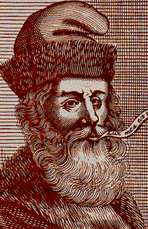
Raymond Lully
If there were any of the alchemists who discovered the mineral agent of transformation, fewer still were able to find its application to the human body. Only a very few adepts knew of the essential agent, the sublime heat of the soul, which fuses the emotions, consumes the prison of leaden form and allows entry into the higher world. Raymond Lully made gold for the King of England. George Ripley gave a hundred thousand pounds of alchemical gold to the Knights of Rhodes, when they were attacked by the Turks. Gustavus Adolphus of Sweden had an enormous number of gold pieces coined that were marked with a special mark because they were of “Hermetic origin.” They had been made by an unknown man under the protection of the king, who was found at his death to possess a considerable quantity of gold. In 1580, the Elector Augustus of Saxony, who was an alchemist, left a fortune equivalent to seventeen million dollars. The source of the fortune of Pope John XXII, whose residence was Avignon and whose revenues were small, must be ascribed to alchemy (at his death there were in his treasury twenty-five million florins). This must be concluded also in the case of the eighty-four quintals of gold possessed in 1680 by Rudolph II of Germany.
The learned chemist Van Helmont and the doctor Helvetius, who were both skeptics with regard to the Philosopher’s Stone and had even published books against it, were converted as a result of an identical adventure which befell them. An unknown man visited them and gave them a small quantity of projection powder; he asked them not to perform the transmutation until after his departure and then only with apparatus prepared by themselves, in order to avoid all possibility of fraud. The grain of powder given to Van Helmont was so minute that he smiled sarcastically; the unknown man smiled also and took back half of it, saying that what was left was enough to make a large quantity of gold. Both Van Helmont’s and Helvetius’ experiments were successful, and both men became acknowledged believers in alchemy. Van Helmont became the greatest “chemist” of his day. If we do not hear nowadays that Madame Curie has had a mysterious visitor who gave her a little powder ” the color of the wild poppy and smelling of calcined sea salt,” the reason may be that the secret is indeed lost; or, possibly, now that alchemists are no longer persecuted or burnt, it may be that they no longer need the favorable judgment of those in official power.
Until the end of the eighteenth century, it was customary to hang alchemists dressed in a grotesque gold robe on gilded gallows. If they escaped this punishment they were usually imprisoned by barons or kings, who either compelled them to make gold or extorted their secret from them in exchange for their liberty. Often they were left to starve in prison. Sometimes they were roasted by inches or had their limbs slowly broken. For when gold is the prize, religion and morality are thrown to the side and human laws set at naught. This is what happened to Alexander Sethon, called “the Cosmopolitan.” He had had the wisdom to hide all his life and avoid the company of the powerful and was a truly wise man. However, marriage was his downfall. In order to please his ambitious wife, who was young and beautiful, he yielded to the invitation extended him by the Elector of Saxony, Christian II, to come to his court. Since Sethon was unwilling to disclose the secret of the Philosopher’s Stone, which he had long possessed, he was scalded every day with molten lead, beaten with rods and punctured with needles till he died.
The famous alchemists Michael Sendivogius, Botticher, and Paykull all spent part of their lives in prison, and many men suffered death for no other crime than the study of alchemy. If a great number of these seekers were impelled by ambition or if there were among them charlatans and impostors, it does not diminish the fact that a great many of them cherished a genuine ideal of moral development. In any event, their work in the domain of physics and chemistry formed a solid basis for the few wretched fragmentary scraps of knowledge that are called modern science and are cause for great pride to a large number of ignorant men.
These “scientists” regard the alchemists as dreamers and fools, though every discovery of their infallible science is to be found in the “dreams and follies” of the alchemists. It is no longer a paradox, but a truth attested by recognized scientists themselves, that the few fragments of truth that our modern culture possesses are due to the pretended or genuine adepts who were hanged with a gilt dunce’s cap on their heads. What is important is that not all of them saw in the Philosopher’s Stone the mere vulgar, useless aim of making gold. A small number of them received, either through a master or through the silence of daily meditation, genuine higher truth. These were the men who, by having observed it in themselves, understood the symbolism of one of the most essential rules of alchemy: Use only one vessel, one fire, and one instrument. They knew the characteristics of the sole agent, of the Secret Fire, of the serpentine power which moves upwards in spirals — of the great primitive force hidden in all matter, organic and inorganic — which the Hindus call kundalini, a force that creates and destroys simultaneously. The alchemists calculated that the capacity for creation and the capacity for destruction were equal, that the possessor of the secret had power for evil as great as his power for good. And just as nobody trusts a child with a high explosive, so they kept the divine science to themselves, or, if they left a written account of the facts they had found, they always omitted the essential point, so that it could be understood only by someone who already knew.
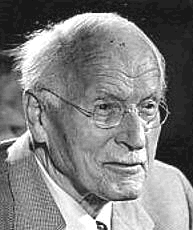
Carl Jung made alchemical methods part of modern psychology.
Examples of such men were, in the seventeenth century, Thomas Vaughan (called Philalethes), and, in the eighteenth century, Lascaris. It is possible to form some idea of the lofty thought of Philalethes from his book Infroitus, but Lascaris has left us nothing. Little is known of their lives. Both of them wandered throughout Europe teaching those whom they considered worthy of being taught. They both made gold often but only for special reasons. They did not seek glory, but actually shunned it. They had knowledge enough to foresee persecution and avoid it. They had neither a permanent abode nor family. It is not even known when and where they died. It is probable that they attained the most highly developed state possible to man, that they accomplished the transmutation of their soul. In others words, while still living they were members of the spiritual world. They had regenerated their being, performed the task of mankind. They were twice born. They devoted themselves to helping their fellow men; this they did in the most useful way, which does not consist in healing the ills of the body or in improving men’s physical state. They used a higher method, which in the first instance can be applied only to a small number, but eventually affects all of us. They helped the noblest minds to reach the goal that they had reached themselves. They sought such men in the towns through which they passed, and, generally, during their travels. They had no school and no regular teaching, because their teaching was on the border of the human and the divine. But they knew that a truthful word, a seed of gold sown at a certain time in a certain soul would bring results a thousand times greater than those that could accrue from the knowledge gained through books or ordinary science.
From the bottom of our hearts we ought to thank the modest men who held in their hands the magical Emerald Formula that makes a man master of the world, a formula which they took as much trouble to hide as they had taken to discover it. For however dazzling and bright the obverse of the alchemical medallion, its reverse is dark as night. The way of good is the same as the way of evil, and when a man has crossed the threshold of knowledge, he has more intelligence but no more capacity for love. For with knowledge comes pride, and egoism is created by the desire to uphold the development of qualities that he considers necessary. Through egoism he returns to the evil that he has tried to escape. Nature is full of traps, and the higher a man rises in the hierarchy of men, the more numerous and the better hidden are the traps.
Saint Anthony in his desert was surrounded by nothing but dreams. He stretched out his arms to grasp them, and if he did not succumb to temptation it was only because the phantoms vanished when he sought to seize them. But the living, almost immediately tangible reality of gold, which gives everything — what superhuman strength would be necessary to resist it! That is what had to be weighed by the alchemical adepts who possessed the Triple Hermetic Truth. They had to remember those of their number who had failed and fallen to the wayside. And they had to ponder how apparently illogical and sad for mankind is the law by which the Tree of Wisdom is guarded by a serpent infinitely more powerful than the trickster serpent that tempted Eve in the Garden of Eden.
